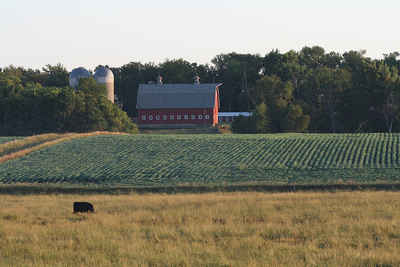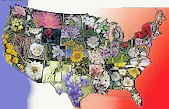South Dakota State Flower
American Pasque Flower

(Pulsatilla hirsutissima)
Adopted on March 5, 1903; 1919
The American Pasque Flower, (Pulsatilla hirsutissima,) was adopted as South Dakota's state flower on March 5, 1903. Also called the May Day flower, prairie crocus, wind flower, Easter flower and meadow anemone, the pasque is one of the first flowers to bloom in the spring (often before the late winter snows have thawed).
In 1919, South Dakota's state flower law was revised, changing the scientific name to Pulsatilla hirsutissima. Originally named the Paschflower by herbalist John Gerade in 1597. From the Hebrew word Pasch, which means Passover.
South Dakota State Flower:
American Pasque Flower

This perennial herb is more commonly called the pasqueflower (psk?flou??r) from the French word Pasque, or "Easter". It grows wild throughout the state, and its blooms are one of the first signs of spring in South Dakota.
A wildflower of the prairie regions of North America, is of the buttercup family having purple, crocus like flowers blooming about Easter. The pasque
flower has often been made the subject of Plains Indian songs and legends. South Dakota's original state flower bill, described it as "the pasque or
wind flower."It was changed to "pasque flower," with the scientific name "Anemone patens.
While many of the other plants in South Dakota haven't even turned green, the pasque flower is peaking above the snow, with its white, pink, or purplish,
tulip-like blossoms already open. The flower's common name is French for Easter, and refers to the plant's habit of flowering between late March and
early June, depending on location.
Characteristics of the South Dakota State Flower
This member of the buttercup family, the pasque is a small, lavender flower, has been given numerous names over the years: Easter flower, May Day flower, gosling flower, wild crocus, prairie crocus, prairie anemone, meadow anemone, sand flower, wind flower and prairie smoke. The scientific genus name, Anemone , means wind flower. The species name, patens , means spreading. The Lakota name for this plant, "hosi' cekpa" translates as "child's navel" and is very descriptive of the plump flower buds that look like a newborn's navel before it heals.
Pasque flowers have a showy, beautiful blossom that is composed of 5 to 7 sepals that look like petals. True petals are lacking. The flowers are radially symmetrical and grow to be 1 to 4 inches (2.5 - 10.2 cm) wide. Leaves on the stem are silky, haired, sessile, and arranged in a whorl beneath the petal-like sepals. The basal leaves, typical of all plants in the buttercup family, have long, hairy petioles and are deeply indented, producing narrow, linear palmate lobes. A similar species, not found in South Dakota is the western pasque flower. It can be distinguished by its smaller flowers that are lighter in color.
Distribution
The pasque flower is found across much of North America from approximately 43 degrees to 60 degrees north latitude. It is found from Alaska, south to Utah, east to Illinois and west to Alberta. Pasque flowers prefer plains, foothills and mountain meadows at altitudes from 4,000 to 10,000 feet (1231-3077 m). In eastern South Dakota, pasque flower growth can be quite luxuriant, though it becomes more sparse west of the Missouri River. With agriculture and ranching, pasque flowers are not as abundant as they once were, but they are still locally common in the Black Hills, Slim Buttes, and Cave Hills.
Natural History
Pasque flowers are the first sign that spring has arrived in South Dakota. These lovely blossoms peak through the snow beginning
in late March. By midsummer, their life cycle is complete.
Anemones are wind flowers; their seeds are dispersed by the wind so that new plants develop away from the parent plant. The plants develop quickly
in the spring by sending out a hairy stem with a whorl of bracts and a flower bud that grows 4 to 15 inches (10-38 cm) in height. As the plant matures,
a woody, persistent stem develops just beneath the soil. Each year, this stem gives rise to new growth of leaves and flowers. The flower will develop
into a 1 to 2.5 inch (2.5-6.6 cm) wide fruiting head with many small fruits (achenes), each of which has a long feathery attachment that can catch
the wind.
South Dakota Laws
The law designating the American pasque flower as the official South Dakota state flower is found in the South Dakota Codified Laws, Title 1, Chapter 1-6, Section 1-6-10.
TITLE 1. STATE AFFAIRS AND GOVERNMENT.
CHAPTER 1-6. STATE EMBLEMS.
SECTION 1-6-10.
1-6-10. State floral emblem. The floral emblem of this state shall be the American pasque flower (pulsatilla hirsutissima) with the motto "I Lead."
Source: SDC 1939, § 55.0109.
Taxonomic Hierarchy: American Pasque Flower
Kingdom: Plantae - Plants
Subkingdom: Tracheobionta - Vascular plants
Superdivision: Spermatophyta - Seed plants
Division: Magnoliophyta - Flowering plants
Class: Magnoliopsida - Dicotyledons
Subclass: Magnoliidae -
Order: Ranunculales -
Family: Ranunculaceae - Buttercup family
Genus: Pulsatilla P. Mill. - pasqueflower
Species: Pulsatilla patens (L.) Mill. - eastern pasqueflower
Subspecies: Pulsatilla patens (L.) Mill. ssp. multifida (Pritz.) Zamels - cutleaf anemone
State Floral Emblems








